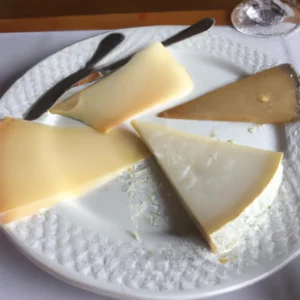When you’re shopping for a new cheese to use in your cooking, you may want to know the differences between Manchego and Bruyere. Manchego is often used in Spanish cooking and can be substituted for gruyere in recipes such as mac and cheese. This cheese is a salty cheese similar to cream, with a slight piquancy and a characteristic aftertaste.
Table of Contents
Comte
For cheese lovers, Comte vs. manchego is a matter of personal preference. Although they have similar rich flavors and texture, they are far more different. Manchego is a Spanish cheese, while Comte is French. Both cheeses have a similar texture and can be found in high-end supermarkets. Comte is a firmer cheese, which gets harder as it ages. The flavor is more robust with a bold aftertaste.
Manchego is made from sheep’s milk and comes from the La Mancha region of Spain. Its rind is usually inedible and features a herringbone basket weave design. Manchego is made in a traditional method, taking 60 days to two years to mature. It becomes softer and tangier the longer it ages, but substitutes must be aged for a similar length of time.

Manchego
A close comparison of the two cheeses will show the difference in their flavors. Manchego is a hard cheese with a nutty flavor and notes of caramel, while Gruyere is a soft, yellow-green cheese. Both cheeses have the same cheese-making process, but the differences between them are most noticeable in their texture. Manchego is best enjoyed out of hand, while Gruyere is best used in cooking. Manchego can be marinated with aromatic green olive oil and herbs, which intensifies its flavors.
Both cheeses are perfect for creamy dishes. The process of making cheese begins when the milk is curdled. The curds are separated from the milk, and the cheese is then squeezed to remove excess water. Cheeses that are curdled with acid or rennet will not melt. However, cheeses curdled without the use of either of these two processes will remain firm and unchewy when cooked.
English cheddar
The first of the two cheeses, English cheddar, originated in southwest England in the 1100s, and has become one of the most popular varieties in the world. Made with milk from cows that are fed grass rich in carotene, it is characterized by a strong, sharp flavor. The white or yellow color of Cheddar is caused by the carotene found in the milk, while the dark hues are from annatto added to the cheese during the aging process. It also has a nutty, earthy flavor and is widely available.
Although both cheeses have sharp and mild flavors, cheddar is slightly milder in taste. Its appearance and flavor are similar to those of Manchego, especially the younger variety. Both have a creamy, buttery flavor. Cheddar is commonly available in grocery stores, but you can substitute Manchego with English cheddar if you prefer a milder cheese. But remember that the older English cheddar will have a stronger flavor than the younger variety.
Parmigiano-Reggiano
When choosing a cheese, it’s important to understand the difference between Parmigiano-Reggiano and Gruyere. Gruyere is known for its rich, buttery flavor, dense crystalline texture, and complex taste. To make a truly delicious cheese, it must begin with raw milk from mainly grass-fed cows. The Alpine grasses and naturally-occurring bacteria add flavor. Then, it must be salted and brined before the cheese is shaped into curds. It’s then heated in giant copper vats to develop a distinctive flavor.
In a heated recipe, both Parmesan and Gruyere are good substitutes. While Parmesan has a slightly different flavor than Gruyere, both have similar texture and taste. Whether you want to make a cheese substitute for Parmigiano-Reggiano or Gruyere, it’s important to know that each cheese is not the same. Some substitutes are more similar than others.
Pecorino Romano
If you’re trying to decide between Pecorino Romano and Gruyere cheese, you’ve probably heard about the difference between the two, but what’s the difference between these two Italian cheeses? Both are good cheeses, but they have slightly different textures and flavors. Pecorino Romano is straw-white, and its salty, sharp flavor is reminiscent of a sheep’s milk cheese. The cheese is also called Locatelli, and is one of the oldest cheeses in Italy. It’s flavorful and has a higher butterfat content than many of its counterparts.
Pecorino is hard cheese, which makes it an ideal grating cheese. It has a similar flavor to Parmesan and is made from sheep’s milk. Pecorino Romano has a protected designation of origin in the European Union, so it must follow strict guidelines for production. It must be produced in Lazio, Grosseto, or Sardinia using sheep’s milk, and it must be aged at least eight months. Both types of cheese are delicious when grated, and they go well with pasta and salads alike.
Raclette
There are many different types of cheese. The three most common are gruyere, raclette and manchego. Each cheese has distinct qualities that make them ideal for certain dishes. Raclette is made with a melted cheese, while manchego is made with a semi-hard cheese. You can also use a combination of these three cheeses for a delicious melting cheese recipe. Read on to learn more about each cheese!
Raclette: Made of raw cow’s milk, raclette is a classic Swiss cheese. Its soft texture is ideal for melting, and the taste varies from region to region. It has a fruity, nutty, milky, and spicy flavor, and the aroma tends to be floral. Because of its melting properties, raclette is an excellent substitute for Gruyere.

